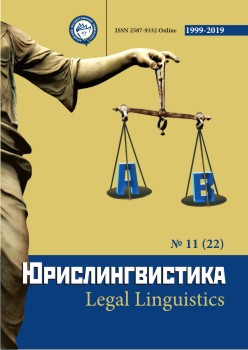TOWARDS THE “CRIME OF VIOLENCE” DEFINITION IN THE СRIMINAL СODE OF THE RUSSIAN FEDERATION
Abstract
T
The article is devoted to the study of the term «violence», which has no legislative definition, and in the academic literature is defined in different ways. The absence of definition in the dispositions of articles does not allow to unambiguously determine in each case the amount of violence involved, and which requires additional qualification. The article proposes two ways to determine the amount of violence in different cases. One of them is connected with the systemic interpretation of the norm in question, and the comparison of the characteristics of the elements essential and the qualifying characteristics. Another way is to compare the sanction of the interpreted norm with the sanctions of the norms establishing responsibility for the use of violence of the disputed volume in its pure form. The issue of dividing violence into physical and mental and ways of fixing these types in the dispositions of the norms of the Criminal Code of the Russian Federation is touched upon. The author notes that there is no uniformity of terminology when fixing these elements in the norms of the Criminal Code of the Russian Federation. The article ponders on the problem of the relationship between the terms "violence", "coercion" and "forcing." It is noted that legislators themselves in different norms lay a different meaning in these terms. It is proposed to understand “coercion” and “forcing” as synonyms. The lack of an official interpretation of the terms “violence dangerous to life and health” and “violence not dangerous to life and health” is criticized as well as the use of explanations provided for them. The author concludes that it is necessary to develop the concept of violence, which means the existence of a general concept, universal terms, general classifications and the scope of various types and forms of manifestations.
Downloads
Metrics
References
Гаухман Л.Д. Проблемы квалификации насильственных преступлений / Уголовное право. – 2014. – № 5.
Девятовская, С. В. Понятие принуждения в российском уголовном праве / Юристъ-Правоведъ. – 2010. – № 2.
Кругликов Л.Л. О понятии и уголовно-правовой оценке насилия / Уголовное право. – 2015. – № 1.
Крылов Н.Г. К вопросу о содержании понятия «насилие» в российском уголовном праве / Вестник саратовской государственной юридической академии. – 2016. – № 5 (112).
Логунова О.С. Насилие и его формы в cт. 117 УК РФ и ст.302 УК РФ / Современные вопросы государства, права, юридического образования: материалы III Общероссийской научно практической Интернет–конференции / отв.ред. О.В. Белянская. Тамбов, 2006.
Ожегов С.И., Шведова Н.Ю. Толковый словарь русского языка. М., 2006.
Сердюк Л.В. Насилие: криминологическое и уголовно–правовое исследование. М., 2002.
Фокин М.С. Содержание понятия «насилие» по действующему уголовному законодательству / Вестник Омского университета. Серия Право. – 2010. – № 3 (24).
Цебоев А.П. Насилие как признак преступного поведения и проблемы его регламентации в нормах российского уголовного закона / Вестник краснодарского университета МВД России. – 2016. – № 1 (31).
Шарапов Р.Д. Теоретические основы квалификации насильственных преступлений. Тюмень, 2005.
Шарапов Р.Д. Физическое насилие в уголовном праве. СПб., 2001.
References
Gauxman, L.D. (2014). Problemy kvalifikacii nasilstvennyx prestuplenij. Ugolovnoe pravo, 5 (in Russian).
Devyatovskaya, S. V. (2010). Ponyatiye prinuzhdeniya v rossiyskom ugolovnom prave. Yurist-Pravoved, 2 (in Russian).
Kruglikov, L.L. (2015). O ponyatii i ugolovno-pravovoj ocenke nasiliya. Ugolovnoe pravo, 1 (in Russian).
Krylov, N.G. (2016). K voprosu o soderzhanii ponyatiya «nasilie» v rossijskom ugolovnom prave. Vestnik saratovskoj gosudarstvennoj yuridicheskoj akademii, 5(112) (in Russian).
Logunova, O.S. (2006). Nasilie i ego formy v ct. 117 UK RF i st.302 UK RF. Sovremennye voprosy gosudarstva, prava, yuridicheskogo obrazovaniya. Proceed. III All-Russian Sc. Internet Conf. Tambov (in Russian).
Ozhegov, S.I., Shvedova, N.Yu. (2006). Dictionary of the Russian Language. Moscow (in Russian).
Serdyuk, L.V. (2002). Nasilie: kriminologicheskoe i ugolovno–pravovoe issledovanie. Moscow (in Russian).
Fokin, M.S. (2010). Soderzhanie ponyatiya “nasilie” po dejstvuyushhemu ugolovnomu zakonodatelstvu. Vestnik Omskogo universiteta. Seriya Pravo, 3(24) (in Russian).
Ceboev, A.P. (2016). Nasilie kak priznak prestupnogo povedeniya i problemy ego reglamentacii v normax rossijskogo ugolovnogo zakona. Vestnik krasnodarskogo universiteta MVD Rossii, 1(31) (in Russian).
Sharapov, R.D. (2001). Fizicheskoe nasilie v ugolovnom prave. Saint Petersburg (in Russian).
Sharapov, R.D. (2005). Teoreticheskie osnovy kvalifikacii nasilstvennyx prestuplenij. Tyumen (in Russian).
Copyright (c) 2019 надежда владимировна тыдыкова

This work is licensed under a Creative Commons Attribution 4.0 International License.
The authors, which are published in this journal, agree to the following conditions:
1. Authors retain the copyright to the work and transfer to the journal the right of the first publication along with the work, at the same time licensing it under the terms of the Creative Commons Attribution License, which allows others to distribute this work with the obligatory indication of the authorship of this work and a link to the original publication in this journal .
2. The authors retain the right to enter into separate, additional contractual agreements for the non-exclusive distribution of the version of the work published by this journal (for example, to place it in the university depository or to publish it in a book), with reference to the original publication in this journal.
3. Authors are allowed to post their work on the Internet (for example, in a university repository or on their personal website) before and during the review process of this journal, as this may lead to a productive discussion, as well as more links to this published work (See The Effect of Open Access).











